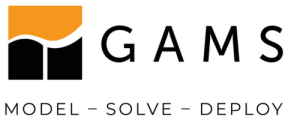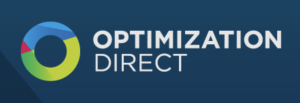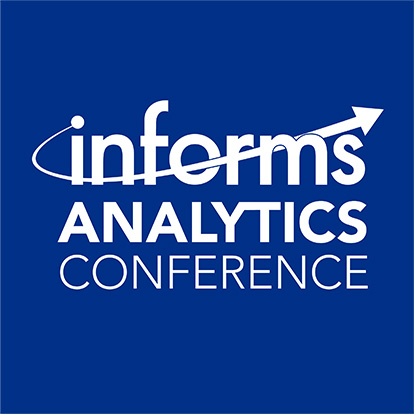Take advantage of these pre-conference workshops for a hands-on demonstration of the latest in Analytics software. All attendees are welcome to join onsite or pre-register. If you’ve already registered for the conference, you can add Exhibitor Workshops by editing your record.
Descriptions and times below:
Sunday, April 14
Time:
11am-12:45pm
Location:
Windsong 1

Global Optimization in FICO® Xpress and Rapid Application Development and Deployment with FICO® Xpress Insight
Presented by: Imre Pólik and Jeff Day
Join us in this workshop to learn about 1) the latest enhancements to the Global optimization solver in FICO® Xpress, and 2) and how FICO® Xpress Insight allows you to put the power of your analytical models in the hands of business users in far less time than traditional tools. Speak directly with FICO experts Dr. Imre Pólik and Dr. Jeff Day at the workshop to learn more!
1. In this talk we are going to present details about the new FICO Xpress Global solver, a new MINLP solver that can handle general nonlinearities (quadratics, trigonometrics, exponentials, powers, etc.) and also any discrete entities supported by Xpress such indicators, special-ordered -sets, semicontinuous variables, etc.). We’ll discuss the internal workings of the solver, its features and recent performance improvements. We will also talk about use cases for a global vs a local solver.
2. FICO® Xpress Insight is a rapid application development and deployment framework that integrates with Xpress Solver and your own analytics, enables collaboration across multi-functional teams, and deploys decision support or automated solutions in the cloud or on-premises in far less time than traditional application development tools. We will show how you can rapidly convert Python and Mosel models into complete business applications with Xpress Insight to make your analytical models available to thousands of business users.
- Associate (Early Career)
- Professional (Mid-Career)
- Executive (Senior Level)
Time:
11am-12:45pm
Location:
Windsong 2

GAMS for Python Users
Presented by: Atharv Bhosekar
Optimization applications (decision support systems) combine technology and expertise from many different disciplines, including numerical modeling and data science. Python is ubiquitous in data pipelines that instantiate optimization models.
GAMS offers several different Python APIs that enable the efficient integration of GAMS and Python – merging the power of a specialized algebraic modeling language with a general programming language. These tools enable application builders to leverage the GAMS language where needed while being flexible enough to bend to many different data pipeline architectures.
- This session will highlight the entire stack of GAMS/Python APIs and tools with two primary use-cases in mind: where GAMS is deployed for optimization alongside Python for data-handling and
- where a single environment is advantageous, such that the algebraic model is developed and solved within a Python environment.
Through several real-world examples, we will explore the benefits of GAMS Transfer Python (a data API to exchange data between GAMS and Python) and our new offering GAMSPy. GAMSPy lets you leverage the high-performance GAMS execution system all from a single Python environment.
- Associate (Early Career)
- Professional (Mid-Career)
- Executive (Senior Level)
Time:
11am-12:45pm
Location:
Windsong 3

How to Deploy applications that combine machine learning/deep learning tools and optimization technologies such as XPRESS/ ODH|XPRESS
Presented by: Robert Ashford
Organizations are increasingly hiring Data Scientists with Open Source skills. They leverage the capabilities and work with Open Source tools like R, Python, Spark, as well as integration with FICO-XPRESS and large data. Come learn how to integrate with Open Source tools to enable clients to get the best of both worlds (Open Source programming and the Modeler GUIs for those who prefer not to code). Furthermore, we will review the latest developments/results in FICO-XPRESS and the new ODH|XPRESS.
- Associate (Early Career)
- Professional (Mid-Career)
- Executive (Senior Level)
Time:
1-2:45pm
Location:
Windsong 3

Hexaly, a New Kind of Global Optimization Solver
Presented by: Frederic Gardi
In addition to the Optimizer, we provide an innovative development platform called Hexaly Studio to model and solve rich Vehicle Routing and Job Shop Scheduling problems in a no-code fashion. The user can define its problem and data, run the Optimizer, visualize the solutions and key metrics through dashboards, and deploy the resulting app in the cloud – without coding. This web-based platform is particularly interesting for educational purposes; it is free for faculty and students.
- Associate (Early Career)
- Professional (Mid-Career)
- Executive (Senior Level)
Time:
1-2:45pm
Location:
Windsong 4

Predictive Modeling with Interactive, No-Code Desktop Software
Presented by: Ross Metusalem
JMP Pro is no-code desktop software for data visualization, statistical analysis, and machine learning. Its combination of an easy-to-use, interactive interface and powerful analytical capabilities makes advanced predictive modeling accessible to practitioners of all skill levels, from students to industry pros.
This workshop presents the end-to-end predictive modeling workflow in JMP Pro via a case study in predicting home equity loan defaults. We’ll begin by summarizing and exploring our training data set using interactive graphics and statistical summaries. We’ll next utilize JMP Pro’s Model Screening platform to efficiently fit and compare multiple candidate models, including neural nets and decision trees. We’ll then perform model tuning and cross-validation to arrive at a final model, interactively explore decision thresholds for scoring new loan applications, and finally export the model to be deployed outside of JMP Pro.
The content you are presenting is most relevant to:
- Associate (Early Career)
- Professional (Mid-Career)
Time:
1-2:45pm
Location:
Windsong 1

The Sushi is Ready. How do I Deliver It? Forecast, Schedule, Route with DecisionOps
Presented by: Ryan O’Neil and Nicole Misek
Countless logistics decisions happen every day for food delivery apps, healthcare scheduling systems, subscription box services, and beyond. Building the models to power said decision making is well practiced. Standing up, managing, and scaling the infrastructure, tooling, and teams that support those models is usually a bespoke practice (if performed at all) and is often what stands in the way of a model’s real-world impact. But it doesn’t have to be.
This hands-on session looks at the story of a sushi roll order, the logistics models (demand forecasting, scheduling, and routing) involved, and the DecisionOps tooling (testing, CI/CD, model management, collaboration) that makes delivering your objectives so much easier than it’s ever been before.
Join us to explore accelerating the impact of models built with OR-Tools, Pyomo, HiGHS, Nextroute, and more.
This content is most relevant to:
- Associate (Early Career)
- Professional (Mid-Career)
- Executive (Senior Level)
Time:
1-2:45pm
Location:
Windsong 2

pandas for Analytics Practitioners, with Applications in Optimization
Presented by: Irv Lustig, PhD
The Python library pandas (http://pandas.pydata.org/) is popular with data scientists, who use it to carry out an entire data analysis workflow in Python. When building analytics models, we often work with data in tables that are sourced from databases, CSV files, and spreadsheets. pandas provides a uniform environment for working with data tables with a large number of methods for manipulating tabular data, many of which are directly applicable for building large scale optimization models. In this workshop, Irv Lustig will present an introduction to pandas and illustrate some of its powerful features that can accelerate optimization model development and deployment.
This content is most relevant to:
- Associate (Early Career)
- Professional (Mid-Career)
- Executive (Senior Level)
Time:
3-4:45pm
Location:
Windsong 2

Prescriptive Analytics from Model to App: Learn how you can build optimization applications quickly and reliably, with AMPL, Python, Streamlit — and AI
Presented by: Bob Fourer, Filipe Brandao, and Gyorgy Matyasfalvi
|
Optimization is the most widely adopted technology of Prescriptive Analytics, but also the most challenging to implement. This presentation takes you through the steps of a proven approach that combines the best features of two implementation environments:
You’ll also see how new AI technology is enabling a rapid development process for both AMPL and Python, reducing the time and effort to produce a working application that’s ready for end-users. This content is most relevant to:
|
Time:
3-4:45pm
Location:
Windsong 4

Learn how ChiAha can help you accelerate your journey from raw data to prediction!
Presented by: Andrew Siprelle
- Associate (Early Career)
- Professional (Mid-Career)
- Executive (Senior Level)
Time:
3-4:45pm
Location:
Windsong 1

Gurobi 11.0 – Helping You to Build, Solve, and Deploy Optimization Models
Presented by: Xavier Nodet, Dan Jeffrey, Jue Xue, and Irv Lustig
In this workshop, attendees will get a look at our latest product release, Gurobi 11.0—including exciting performance improvements to Gurobi’s core algorithms. We’ll do a walkthrough of Gurobi’s new Mixed-Integer Nonlinear Programming (MINLP) capabilities and highlight features that make the model-building and solving process easier.
In the second half of the workshop, we will show a preview of our new price optimization demo. We will also have special guest Irv Lustig, Optimization Principal at Princeton Consultants, join us and illustrate best practices for using pandas with Gurobi via examples. Don’t miss this special workshop!
This content is most relevant to:
- Associate (Early Career)
- Professional (Mid-Career)
- Executive (Senior Level)
Time:
3-4:45pm
Location:
Windsong 3

SAS Analytics and Customized Optimization Solutions
Presented by: Rob Pratt and Subramanian Pazhani
SAS offers extensive analytic capabilities, including machine learning, deep learning, natural language processing, statistical analysis, optimization, and simulation. SAS analytic functionality is also available through the open, cloud-enabled design of SAS® Viya®. You can program in SAS or in other languages – Python, Lua, Java, and R. SAS Analytics is equipped with AI-enabled automations and modern low-code or no-code user interfaces that democratize data science usage in your organization and offer unparalleled speed to value.
We will first review the SAS analytics portfolio, then highlight recently added optimization features, and finally explore case studies in optimization, focusing on custom-built solutions that combine heuristics with optimization algorithms. Complex business problems typically need advanced analytics tools and solutions to efficiently solve them, with flexibility to create analytics pipelines that use complementary solution techniques. We will discuss customer business problems and share how to use SAS multi-stage analytics solution approaches. During the discussion, we will highlight the capabilities and flexibility of SAS in seamlessly implementing these multi-stage custom-built optimization solutions. We will conclude with an overview of SAS customer outcomes from various analytics projects.
This content is most relevant to:
- Associate (Early Career)
- Professional (Mid-Career)
- Executive (Senior Level)

